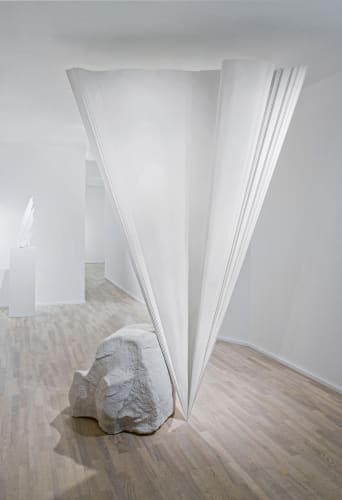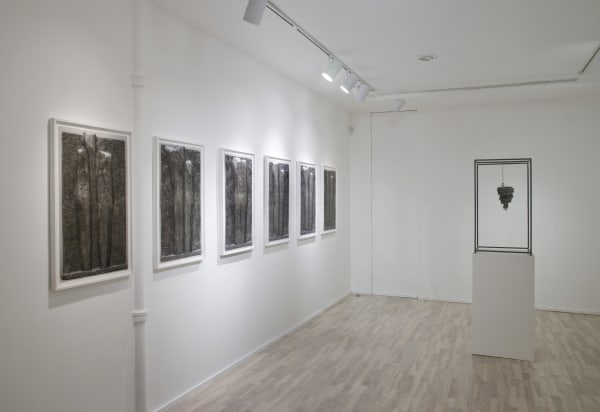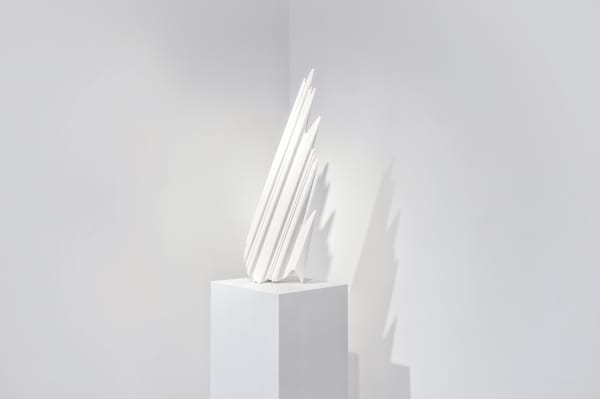Sculpture (1504-2013): Churner and Churner, New York
Here the relationship between figure and ground, already at stake in Matisse’s production, falls away, and the compromised forms collapse not into difference but repetition. Unlike the exclamation point of The Present Is Just a Point, the grammatical comparison here would be the ellipses, a subtle fade to black. The trickster makes this world...
27 August 2013
Exhibition: Nick Hornby
Sculpture (1504-2013)
Dates: September 19 – November 2, 2013
Opening reception: Thursday, September 19, 6-8pm
Churner and Churner is delighted to present the first solo U.S. exhibition of British sculptor Nick Hornby. “Sculpture (1504-2013)” brings together three new works by the artist, each of which progress his enquiry into citation and abstraction.
In The Present Is Just a Point, Michelangelo’s David has been extruded to a single point. Standing 9-ft tall and made from half a ton of 150-micron marble dust, the apotheosis of human perfection is reduced to zero, the impeccable curves and relaxed contrapposto of David stretched to their endpoint. The horizontal extrusion is stood erect balancing on its tip, supported by a boulder in the same way historic figures are braced by adjacent rocks or conveniently placed tree trunks. In an inversion of the process of carving (removing) to a gesture of modeling (adding), Hornby commissioned a traditional stone carver from Carrera, Italy, to come to London and model a rock in terracotta at his studio.
David’s face appears in a second work, this time mirrored upon itself at a degree angle to make a new compound face. The result is an anamorphosis, the face skewed so severely that it is recognizable only from an acute angle. This Pinocchioesque head is suspended in a bronze cage, much like that of Giacometti’s Nose. In both the resin and bronze versions, the profile becomes an unsettling moment of aggression, not quite the gun-shaped sculpture of Giacometti, but a startling disfiguration of beauty.
Finally, Hornby departs from his more typical gleaming white curves with nine photographs. Hornby has digitally manipulated Matisse’s The Backs (1909-31) in order to extrapolate hypothetical future iterations beyond Matisse’s works, themselves a progression further and further into abstraction. Representing the back view of a woman, he was able to consider the nude as an arrangement of forms that could be simplified; by the end the modeling of flesh gave way almost completely to geometric forms. Here the relationship between figure and ground, already at stake in Matisse’s production, falls away, and the compromised forms collapse not into difference but repetition. Unlike the exclamation point of The Present Is Just a Point, the grammatical comparison here would be the ellipses, a subtle fade to black. The trickster makes this world.
-

Cultured Magazine: History Lessons with Nick Hornby – Maxwell Williams
Maxwell Williams, Cultured Magazine, September 7, 2017 -

Frieze: Nick Hornby, Churner and Churner – Ara H. Merjian
Ara H. Merjian, Frieze, March 17, 2014 -

Wall Street International: Nick Hornby, Sculpture (1504-2013) – Churner and Churner Gallery
Wall Street International, October 28, 2013 -

The New York Times: Nick Hornby: 'Sculpture (1504-2013)' – Karen Rosenberg
Karen Rosenberg, The New York Times, October 17, 2013




